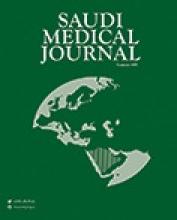Abstract
OBJECTIVE: To analyze the instrumental deliveries carried out at the Armed Forces Hospital, Riyadh, Kingdom of Saudi Arabia during the year 2000 and compare the outcome of ventouse and forceps deliveries.
METHODS: A retrospective case note review of all instrumental deliveries, carried out at the Armed Forces Hospital, Riyadh, during the year 2000.
RESULTS: Three hundred and four vaginal deliveries, of whom 258 were ventouse and 46 were forceps deliveries, were assisted. Seventy percent of forceps deliveries were carried out in primigravida as compared to 49% of ventouse deliveries. Fetal distress was the indication in 81.4% of ventouse deliveries as compared to 76% of forceps deliveries. Prolonged 2nd stage of labor was an indication in 11% of forceps and 2.3% of ventouse deliveries. Consultants and Senior Registrars were more likely to use forceps while registrars use ventouse as their preferred instrument for delivery. Attempted ventouse delivery was successful in 91.4% as compared to 95.7% in forceps. Extension of an episiotomy was more likely to occur with ventouse than forceps deliveries while 3rd degree perineal tear occurred more with forceps deliveries. Babies who had attempted ventouse deliveries have lower apgar score at one minute than attempted forceps. No babies required admission to neonatal intensive care unit. There was only one stillbirth in the ventouse delivery group due to intrapartum asphyxia and true knot in the umbilical cord.
CONCLUSION: Forceps is more likely to be used in the primigravida and prolonged 2nd stage of labor and less likely to fail. Ventouse is more likely to be used by registrars. Extension of an episiotomy and low apgar score at one minute is more likely to occur with ventouse deliveries.
- Copyright: © Saudi Medical Journal
This is an open-access article distributed under the terms of the Creative Commons Attribution-Noncommercial-Share Alike 3.0 Unported, which permits unrestricted use, distribution, and reproduction in any medium, provided the original work is properly cited.






